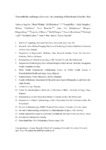Mostrar o rexistro simple do ítem
Osteoarthritis endotype discovery via clustering of biochemical marker data
| dc.contributor.author | Angelini, Federico | |
| dc.contributor.author | Widera, Pawel | |
| dc.contributor.author | Mobasheri, Ali | |
| dc.contributor.author | Blair, Joseph | |
| dc.contributor.author | Struglics, André | |
| dc.contributor.author | Uebelhoer, Melanie | |
| dc.contributor.author | Hentorin, Yves | |
| dc.contributor.author | Marijnissen, Anne CA | |
| dc.contributor.author | Kloppenburg, Margreet | |
| dc.contributor.author | Blanco García, Francisco J | |
| dc.contributor.author | Haugen, Ida K. | |
| dc.contributor.author | Berenbaum, Francis | |
| dc.contributor.author | Ladel, Christoph | |
| dc.contributor.author | Larkin, Jonathan | |
| dc.contributor.author | Bay-Jensen, Anne C. | |
| dc.contributor.author | Bacardit, Jaume | |
| dc.date.accessioned | 2022-10-27T09:38:51Z | |
| dc.date.available | 2022-10-27T09:38:51Z | |
| dc.date.issued | 2022-04-08 | |
| dc.identifier.citation | Angelini F, Widera P, Mobasheri A, Blair J, Struglics A, Uebelhoer M, Henrotin Y, Marijnissen AC, Kloppenburg M, Blanco FJ, Haugen IK, Berenbaum F, Ladel C, Larkin J, Bay-Jensen AC, Bacardit J. Osteoarthritis endotype discovery via clustering of biochemical marker data. Ann Rheum Dis. 2022 May;81(5):666-675. | es_ES |
| dc.identifier.issn | 0003-4967 | |
| dc.identifier.uri | http://hdl.handle.net/2183/31903 | |
| dc.description.abstract | [Abstract] Objectives: Osteoarthritis (OA) patient stratification is an important challenge to design tailored treatments and drive drug development. Biochemical markers reflecting joint tissue turnover were measured in the IMI-APPROACH cohort at baseline and analysed using a machine learning approach in order to study OA-dominant phenotypes driven by the endotype-related clusters and discover the driving features and their disease-context meaning. Method: Data quality assessment was performed to design appropriate data preprocessing techniques. The k-means clustering algorithm was used to find dominant subgroups of patients based on the biochemical markers data. Classification models were trained to predict cluster membership, and Explainable AI techniques were used to interpret these to reveal the driving factors behind each cluster and identify phenotypes. Statistical analysis was performed to compare differences between clusters with respect to other markers in the IMI-APPROACH cohort and the longitudinal disease progression. Results: Three dominant endotypes were found, associated with three phenotypes: C1) low tissue turnover (low repair and articular cartilage/subchondral bone turnover), C2) structural damage (high bone formation/resorption, cartilage degradation) and C3) systemic inflammation (joint tissue degradation, inflammation, cartilage degradation). The method achieved consistent results in the FNIH/OAI cohort. C1 had the highest proportion of non-progressors. C2 was mostly linked to longitudinal structural progression, and C3 was linked to sustained or progressive pain. Conclusions: This work supports the existence of differential phenotypes in OA. The biomarker approach could potentially drive stratification for OA clinical trials and contribute to precision medicine strategies for OA progression in the future. | es_ES |
| dc.language.iso | eng | es_ES |
| dc.publisher | BMJ | es_ES |
| dc.relation | info:eu-repo/grantAgreement/EC/FP/115770 | |
| dc.relation.uri | http://dx.doi.org/10.1136/annrheumdis-2021-221763 | es_ES |
| dc.rights | This article has been accepted for publication in Annals of the Rheumatic Diseases following peer review, and the Version of Record can be accessed online at BMJ Journals web page. | es_ES |
| dc.subject | Epidemiology | es_ES |
| dc.subject | Knee | es_ES |
| dc.subject | Osteoarthritis | es_ES |
| dc.title | Osteoarthritis endotype discovery via clustering of biochemical marker data | es_ES |
| dc.type | info:eu-repo/semantics/article | es_ES |
| dc.rights.access | info:eu-repo/semantics/openAccess | es_ES |
| UDC.journalTitle | Annals of the Rheumatic Diseases | es_ES |
| UDC.volume | 81 | es_ES |
| UDC.issue | 5 | es_ES |
| UDC.startPage | 666 | es_ES |
| UDC.endPage | 675 | es_ES |
Ficheiros no ítem
Este ítem aparece na(s) seguinte(s) colección(s)
-
INIBIC- REUMA - Artigos [184]











